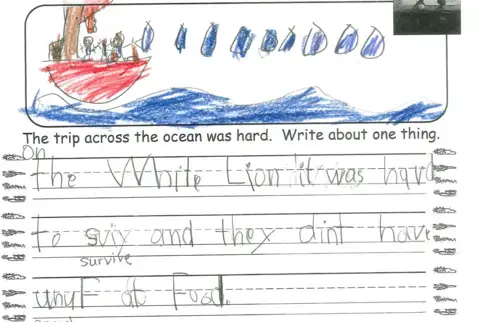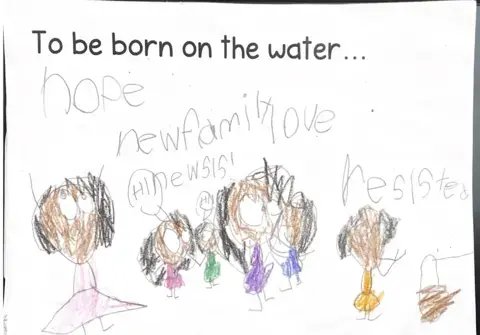This unit was created by the Educators from Lowell Community Public Charter School team as part of the 2022 cohort of The 1619 Project Education Network. It is designed for facilitation across approximately two weeks.
Objectives
I can tell the difference between an author and illustrator—and name them for a story. Students will complete a two-column notes chart for the set of picture books.
I can look at various elements of the book art and tell why they are important. Students will help the teacher label a poster of book parts.
I can analyze an illustration and talk about the connection of the picture to the text.
Unit Overview
Read-aloud storytime is a treasured part of Kindergarten. Too often young learners are “read to” instead of “read with.” This unit uses the Whole Book Approach which treats the picture book as an art form and invites children to analyze and critique all the physical elements of a picture book to help make meaning of rigorous text. This approach to story time was developed by Megan Dowd Lambert, in association with The Eric Carle Museum of Picture Book Art. We encourage teachers to read her book Reading Picture Books To With Children: How to Shake Up Storytime and Get Kids Talking About What They See for examples of techniques to use. Many picture books about enslavement and resistance contain difficult text for 5- and 6-year-old students. Using the illustrations as a springboard, these concepts are more accessible to understand.
The unit uses a text set that addresses enslavement and themes of resistance, resilience and hope, which is also developmentally appropriate for the target age (5–7-year-old’s). The daily lessons introduce various elements of picture book design and provide an opportunity to discuss the importance and impact of these elements for the respective stories. The book elements include: the jacket and covers, endpapers, front matter, typography, page design, gutter, frames, trim size, orientation, and back matter. The second week of the unit concludes with a detailed analysis of these elements in Born on the Water by Nikole Hannah-Jones and Renée Watson. Students will complete text reflection responses for each story in the text set and each poem in Born on the Water. The reflections will ask students to use details from the stories to identify the emotions of the characters, describe why characters act in particular ways, and make text-to-self connections.
The culminating lesson (Day 11) involves a class discussion to review each of the books in the text set to make some syntheses of their learning about enslavement, resistance and resilience. Students then create their own collage posters to illustrate their understanding of what it means “To be born enslaved” and “To be born on the water”…
One word about the lesson plan design: The Whole Book Approach focuses on student discussion of the illustrations and the connection of the art to text. The approach encourages students to drive the discussion. Given their young age and limited experience discussing such weighty topics, questions in bold are written for potential use to help guide the discussion, as needed. After implementing the lessons as written, it became clear that the writing component of the Performance Tasks should be completed in a separate time slot later in the day. The story discussions are invaluable and will take a while. Don’t skimp—and do the writing later when the children’s energy is fresh.
Performance Task:
Students engage with text reflection responses for each book in the text set. Performance tasks appear at the end of each daily lesson. Performance Tasks for each lesson [.pdf] [.docx]
Assessment/Evaluation
Performance Tasks rubric [.pdf][.docx]
Rubrics for each performance task are also located at the end of each lesson.
11 lessons implemented over two weeks that include pacing, texts and multimedia resources. Download below, or scroll down to review key resources included in the unit plan.
Unit Resources
| Resources from The 1619 Project | Born on the Water by Nikole Hannah-Jones, Renée Watson, Nikkolas Smith |
| Additional focus texts | The Year We Learned to Fly by Jacqueline Woodson, illustrated by Rafael Lopez The Oldest Student: How Mary Walker Learned to Read by Rita Lorraine Hubbard; illustrated by Caldecott Honor Winner Oge Mora Your Legacy: A Bold Reclaiming of Our Enslaved History by Schele Williams; illustrated by Tonya Engel Dave the Potter: Artist, Poet, Slave by Laban Carrick Hill; illustrated by Bryan Collier A Birthday Cake for George Washington by Ramin Ganeshram; illustrations by Vanessa Brantley-Newton |
| Teaching Materials | Graphic organizers: After teaching the unit, we concluded the Performance tasks should be implemented in a separate writing block. To help students better understand and remember key details, we created graphic organizers that can be filled out in the whole group during or after the read aloud session. The Year We Learned to Fly Graphic organizer[.pdf][.docx] The Oldest Student: How Mary Walker Learned to Read graphic organizer [.pdf][.docx] Your Legacy: A Bold Reclaiming of Our Enslaved History Graphic organizer [.pdf] [.docx] Dave the Potter: Artist, Poet, Slave Graphic Organizer [.pdf][.docx] Performance Task—Reading Response Journals for all lessons [.pdf] [.docx] A Birthday Cake for George Washington Performance Task Graphic Organizer [.pdf][.docx] Book Model: It is highly recommended you make a book model to help teach the vocabulary for elements of book design. The resources section includes PDF for vocabulary words and a PDF with an example model. We used foam poster board for the covers and posterboard for the pages. The vocabulary words are attached with Velcro dots, so they can be added to the model as introduced in various books. Choose pictures to match the vocabulary words. Images with whole-book approach vocabulary that will be used throughout the unit [.pdf] Book model vocabulary [.pdf][.docx] Performance Task Reading Response powerpoint for all lessons [.pptx] Performance Task rubric for all lessons [.pdf][.docx] Images with whole-book approach vocabulary that will be used throughout the unit [.pdf] |
| Additional readings to prepare for this unit | “When are children old enough to learn about slavery?” by Joe Heim for The Washington Post Dowd Lambert, Megan. (2015) Reading Picture Books “Amid Controversy, Scholastic Pulls Picture Book About Washington's Slave : The Two-Way” by Eyder Peralta for NPR “NOT Recommended: A Birthday Cake for George Washington” by Allyson Criner Brown for Teaching for Change “A Birthday Cake for George Washington: The Problem with Banishing Books” - National Coalition Against Censorship |
Common Core Standards:
CCSS.ELA-LITERACY.RL.K.6
With prompting and support, name the author and illustrator of a story and define the role of each in telling the story.
CCSS.ELA-LITERACY.RL.K.7
With prompting and support, describe the relationship between illustrations and the story in which they appear (e.g., what moment in a story an illustration depicts).
CSS.ELA-LITERACY.RL.K.10
Actively engage in group reading activities with purpose and understanding.
CCSS.ELA-LITERACY.RL.K.3
With prompting and support, identify characters, settings, and major events in a story.
CCSS.ELA-LITERACY.RF.K.1
Demonstrate understanding of the organization and basic features of print.
CCSS.ELA-LITERACY.RF.K.1.A
Follow words from left to right, top to bottom, and page by page.
CCSS.ELA-LITERACY.W.K.1
Use a combination of drawing, dictating, and writing to compose opinion pieces in which they tell a reader the topic or the name of the book they are writing about and state an opinion or preference about the topic or book (e.g., My favorite book is...).
CCSS.ELA-LITERACY.W.K.3
Use a combination of drawing, dictating, and writing to narrate a single event or several loosely linked events, tell about the events in the order in which they occurred, and provide a reaction to what happened.
CCSS.ELA-LITERACY.L.K.4
Determine or clarify the meaning of unknown and multiple-meaning words and phrases based on kindergarten reading and content.
The following examples reflect the work of Kindergarten students from Lowell, MA who engaged with this unit in early 2023.
1. At the start of the unit, students explore the Whole Book Approach to exploring books. They are introduced to vocabulary to describe different parts of a book, and then they practice identifying those elements in various books. (Click here for images of how engaging with this vocabulary) As they review these elements they also begin to analyze details from the stories they are reading, and also analyze how text and illustrations support the storytelling and reflect the story's themes. The following performance tasks reflect students' analysis of each of the texts explored in the unit.
Mary made me feel impressed when she learned to read. I am glad because Mary worked hard.
-Student from Lowell, MA in response to the book The oldest student: How mary walker learned to read
2. While reading Born on the Water, students respond to the following prompts:
The people were strong and they were proud and they were joyful.
-Student from Lowell, MA in response to the book, Born on the water

3. After reading Born on the Water, students respond to the following prompts:


